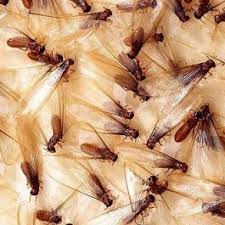Swarms in the spring, mud tubes along the foundation and hollow sounding wood are all signs that termites may be in your house. While spring is sometimes considered the most active time for termites, they have the potential to destroy your property no matter the month or season. Since mature termite colonies can have populations that match those of large cities, checking for signs of termites in the house and executing prevention measures are critical in the effort to deter termites’ arrival, as well as their decimation of your property and peace of mind. Learn more about the signs of termites in and around your house and how the termite control experts at Eliminate ‘Em can help you protect your home and your loved ones.
5 SIGNS of Termites in Your House
Property owners must be vigilant in looking for termite signs and routinely engage termite control and inspection services, like those available from local Eliminate ‘Em providers. This guide to the differences between termites and carpenter ants can help distinguish termites in appearance. However, knowing these common signs of termite damage is a more reliable way to determine if you have a termite problem, since termites themselves are often hidden from view. Although there are many different types of termites and the degree and kind of damage that they do varies accordingly, here are five signs that termites are likely in your house.
- Mud tubes or termite tunnels: Food and moisture may attract termites to your home, but you won’t see them crawling across the kitchen counter to find either one. Instead, they construct mud tubes from their own bodily fluids and the remnants of chewed wood materials that they consume for nutrients. Check foundations and basements, as well as attics and crawl spaces, for this sign of termites in your house. These tunnel structures may also appear outside if there are termites in your yard.
- Swarms: In each termite colony, some termites play a reproductive role and grow wings in order to do so. These winged termites or alates “swarm” in order to mate with fliers from other colonies, and then each couple works to establish and grow a new colony. Dead termites on a windowsill or a cloud-like collection of flying insects outside may signify that this process is occurring. This termite sign may indicate that a termite problem is already present or is beginning to emerge.
- Wings and fecal matter: In addition to finding termite bodies during the swarming period, these swarmers also lose their wings during this process, so wings and wing parts are a sign of termites that can be found in and around the house. Termite excrement may also be visible near wood structures and take the form of tiny pellets or dust that is similar in color to the wood.
- Pinholes and dark dots on the wall: Termites may be most known for eating wood, but they are really after the cellulose in wood and other materials. Consequently, even drywall and wallpaper may become their food sources. Termite signs, like pinholes and dark dots on the walls, can result from tunnel construction, as they travel to and from this particular food source.
- Sagging or blistering surfaces: Termite signs can be seen in many locations and on many surfaces throughout the home. Ceilings and floors may sag under pressure due to termite consumption. Paint on any surface may start to crack or peel, while tile or laminate installations may become loose or begin to buckle. Wood structures may sound hollow when knocked or simply crumble when touched. If termites in the house are left unchecked, a long-term termite infestation can cause this kind of extensive damage and other costly repair issues.
PREVENTING AND ADDRESSING TERMITES IN THE HOUSE
From the basement to the attic, your home is vulnerable to termites. Unfortunately, seeing one or more of the termite signs listed above may be only one indicator of the damage that their presence has caused. Homeowners’ attention to these signs, to learning about termites, and to requesting routine termite inspections by professional termite extermination specialists are proactive measures that can help guard against an infestation. Professional pest control providers, like Eliminate ‘Em, can also recommend other preventative services to help protect your house against termites. Once termites are discovered in the house or their presence is suspected, immediately contacting the Eliminate ‘Em experts in your service area is the most expedient way to find an effective solution to your termite issue.
Remember: proactive care is the best way to avoid the stress and damage that termites can cause. For immediate termite control services or to schedule a termite inspection, submit this form or call the Eliminate ‘Em team today.



